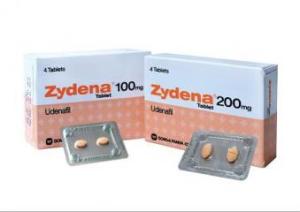Udenafil like Sildenafil, Tadalafil, Avanafil, and Vardenafil (Viagra®, Cialis®, Stendra ® and Levitra® respectively) is an orally taken PDE-5 inhibitor. Its function is very similar in that it blocks the action of phosphodiesterase type 5 and relieves erectile dysfunction in men.
 Udenafil is produced by Dong-A PharmTech Co Ltd. from Korea and has actually been used there since Nov 2005 and marketed as Zydena® and has since been approved for use in Russia in 2008. An indication that it may indeed prove to be a factor in the ED medication mix in the US one day.
Udenafil is produced by Dong-A PharmTech Co Ltd. from Korea and has actually been used there since Nov 2005 and marketed as Zydena® and has since been approved for use in Russia in 2008. An indication that it may indeed prove to be a factor in the ED medication mix in the US one day.
Advantages
- rapid and predictable onset of action
- provides necessary to erection hardness
- increases the axial load on the penis
- reduces the time of the refractory period (time after ejaculation until the next erection)
- optimal duration of up to 24 hours
- high safety profile in the class of PDE-5 inhibitors
- Drinking alcohol and fatty food does not affect the action of Udenafil
Availability
Although Russian and Malaysian men have access to Zydena, countries such as the US, Europe and Canada might be in for a longer wait. Approval processes in these countries go through phases and are much more detailed and complex.
Udenafil Dosing and Administration
Pills taken by mouth, with or without food, for 30 minutes before the alleged sexual activity.
Recommended dose – 100 mg. If necessary, taking into account individual performance and portability, the dose may be increased to 200 mg. The maximum recommended frequency of application – 1 times / day.
Research
News out in Nov 9th 2009 reveals that Dong-A- PharmTech Co Ltd and its US partner Warner Chilcott have initiated phase 3 testing here in the United States. It includes approximately 1120 patients currently suffering from Erectile Dysfunction. These testing will be double bind, randomized with a placebo to carefully study its effectiveness and being careful not to show a bias.
Original studies in Korea showed that in a 12 weeks scientific study that there was a reported 92% penetration success rate versus 53% for the placebo. The overall patient experience also was rated at a 89% satisfaction verses the placebo satisfaction rate or 26%. It had a fairly rapid onset to be able to compete with existing ED treatments and had a long duration of up to 24 hours. Side effects reported where similar to Sildenafil or Tadalafil with some patients experiencing skin flushing and or headache.
What benefit does a drug like Udenafil have over Sildenafil, Tadalafil, Vardenafil or other experimental treatments like Avanafil? It would be how it interacts with each individual. Udenafil would provide an alternative to existing forms of treatment if accepted. Everyone’s body chemistry interacts differently on some scale with medications introduced. For this reason, Udenafil may prove to “work better” for one individual over another. Also related is someone’s sexual profile and habits, the onset speed and how long it lasts may favor someone over another. Clinically it has to be centered on the patient along with follow up on how it seems to be working.
In 2009 Dong-A Pharmaceutical Co., Ltd. and Dong-A PharmTech, Co. Ltd. announced that it had completed a 240 patient once-a-day dosing clinical study of udenafil, its new long acting phosphodiesterase type 5 (PDE-5) inhibitor for erectile dysfunction (ED). The multi-center study conducted in Korea was a randomized, double-blind, placebo-controlled study, designed to investigate the efficacy and safety of udenafil in patients with ED. Following a 4-week non-drug baseline period, 240 men with ED of broad etiology and severity were randomized to one of four treatment groups: Placebo, udenafil 25 mg, udenafil 50 mg or udenafil 75 mg. Patients took one tablet a day for 12 weeks with evaluations every 4 weeks. The primary efficacy endpoint was the change in the standard International Index of Erectile Function (IIEF) Erectile Function Domain (EF) score from baseline to final visit. The secondary efficacy endpoints were the change from the baseline in the mean vaginal penetration success rates and mean intercourse completion rates calculated from the Sexual Encounter Profile (SEP) questions 2 and 3. In addition a sub-group analysis was conducted to determine efficacy in the patients that had lower urinary tract symptoms associated with benign prostatic hyperplasia in addition to erectile dysfunction.
